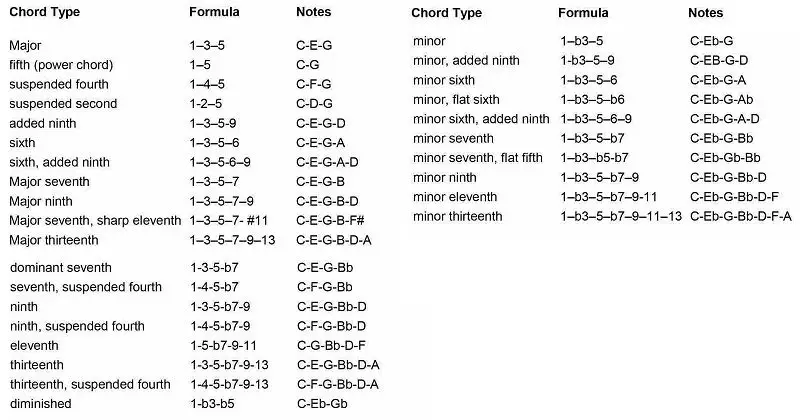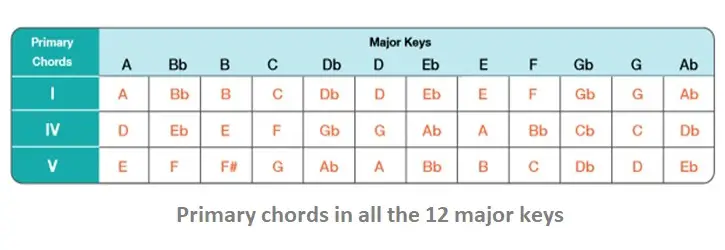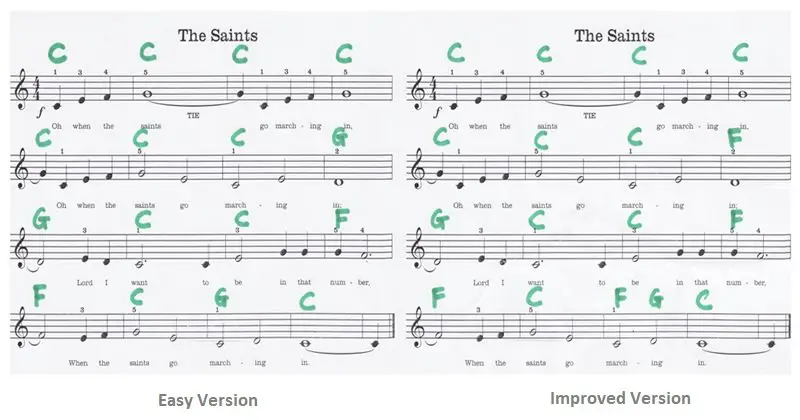What are Chords in Music?
Chords in music are set of notes played together to enhance the overall sound. It is used primarily for harmonizing a melody. Harmonizing simply means adding notes around the melody note to produce a far richer sound.
So for example, to play a C chord, you will press the notes, C, E and G together at the same time.
In the simplest form, you play a piano chord with your left hand while your right hand is busy playing the melody. Pros play chords with both their hands, with the melody becoming the top note of the chord played on the right hand.Types of Chords
A basic chord is a combination of three notes and derives its name from the name of the bottom note, also known as the Root Note. Some of the popular basic chords are – Major, Minor, Diminished and Augmented.
Most of the other chords are derived from the basic chords by adding more notes to it.
The most basic chord is the TRIAD. A chord made of three notes is known as a triad. A triad will have a root note and the third and fifth note above the root note.
There are several types of chords that differ from each other in the manner in which it is constructed.
- Major: C + E + G
- Minor: C + Eb + G
- Fifth (power chord): C + G
- Diminished: C + Eb + Gb
- Major Seventh: C + E + G + B
- Minor Seventh: C + Eb + G + Bb
- Dominant Seventh: C + E + G + Bb
- Suspended: C + D + G (Sus2 Chords)
- Suspended: C + F + G (Sus4 Chords)
- Augmented: C + E + G#
- Extended: These inlcude ninth, eleventh and thirteenth chords.
A major chord sounds bright and lively, as opposed to the minor chord which has a tinge of sadness associated with them.

Seventh Chords
These chords use four notes. One more note is added to a triad in order to get the seventh note.
The most common seventh chords are:
- Dominant 7 (or just “7”) – is a major triad with a minor 7 added.
- Minor 7 – is a minor triad with a minor 7 added.
- Diminished 7 – is a diminished triad with a diminished 7 added.
- Half diminished – is a diminished triad with a minor 7 added.
There are many more “triad + 7” combinations than mentioned here, but these are the more commonly used.
Similar to seventh chords, you also have ninth, eleventh and thirteenth chords as well. As of now, you can just stick to the seventh chords.
Chord Inversions
A chord with its root note at the bottom is called the root position of the chord. However, the same chord can be played in other ways as well.
Chord Inversions is about rearrange the sequence of the notes in the chord. You don’t always have to play a chord in the root position. You can rearrange the notes of a chord in a different order. When you do that, the chord is said to be “inverted”.
When the third of the chord (e.g. E in a C major triad) is at the bottom, it is said to be in first inversion. When the fifth of the chord (G in a C major triad) is at the bottom, it is said to be in second inversion.
Example
The notes of C Major chord, played in the Root position, would be C E G. Now this same chord can be played in different inverted forms.
E G C – First Inversion
G C E – Second Inversion
The most important use of chord inversions is that you can easily move from one chord to another, with minimum shifting of your hands. For instance, if you have to move from C Major chord to A Minor chord, you only need to move one note.
C Major (Root position) – C E G
A Minor (First Inversion) – C E A
So you can clearly see the advantage of using chord inversions here – minimum hand movement!
What are Primary Chords and how to use them
Primary chords are those that are built on 1st note, 4th note, and the 5th note of that key/scale. The primary chords are denoted as Chord I, Chord IV and chord V. So if you consider the C scale, the primary chords will be the C, F & the G chords.

While there are hundreds of chords, the fact is that you can play several songs by knowing just the primary chords. Though eventually you’ll need to learn these in all the keys, to begin with, you can learn to play the primary chords in a few keys.

Extended Chords
A basic chord consists of only three notes. But there are other types of chords that require more than three notes. These chords are actually variations made to the basic chords wherein additional notes are added besides the normal ones. These chords are known as Extended chords.
Actually, any note can be added to a basic chord to form an extended chord but the more popular ones include Sixth Chord, Major Seventh Chord, Minor Seventh Chord, Seventh Chord, Ninth Chord.
Here’s how these chords are constructed. We will take C as the Root Note.
- C Sixth or C6: C E G A (C major chord plus the major sixth note from the C major scale)
- C Major Seventh or C maj7: C E G B (C major chord plus the major seventh note from the C major scale)
- C Minor Seventh or C min7: C Eb G Bb (C minor chord plus the flattened seventh note from the C major scale)
- C Seventh or C7: C E G Bb (C major chord plus the flattened seventh note from the C major scale)
- C Ninth or C9: C E G D (C major chord plus the ninth note of the C major scale i.e. D)
Chord Progressions: Which Chord Comes Next?
A chord progression is a series of musical chords used while playing any song or piece of music. Here are techniques that will help you know which chord to play next while playing a song.
Here are some common progressions that you can use right away.
- IV – V – I
- II – V – I
- I – V – VI – IV
We also learnt about PRIMARY CHORDS (I, IV and V chords); these are used more frequently than other chords, and you’re more likely to use them to play a song. So, if you’re playing in the Key of C, the first chord usually will be the C chord. That leaves us with the F chord and the G chord, which are the other primary chords.
Now, if the melody note is “B”, then the chord is probably a G chord as the “B” note appears in the G chord, but its NOT there in the F chord. Similarly, if the melody note is “A”, than I would use the F chord as the “A” note is present in the F chord, but its NOT present in the G chord.
How To Play Piano Chords: More Suggestions
Here are some suggestions on how to play piano chords.
Arpeggios/Broken Chords
An easy way of playing chords is to play the notes of a chord in an arpeggiated manner i.e. play arpeggios with your left hand. Play a constant up and down pattern to accompany the melody.
Fixed/Block Chords
Another easy method of playing chords is to play straight chords i.e. all the notes together, you can choose to play the chords in the root position or use any of the inversions. You will need to try out various rhythmic patterns while playing in this style.
Chord Picking
Play the chords in a pattern that alternates between the bass note and the remaining two notes i.e. play the root note on one beat and the other two notes together on the next beat. Keep on repeating the same pattern.
Right Hand Chords
This is an advanced way of playing chords where you play chords with both the hands, with the melody note becoming the top note of the chord played on the right hand.
Leave a Reply